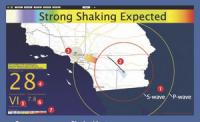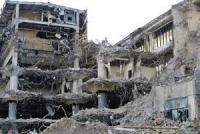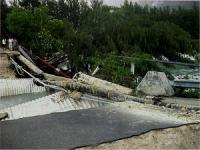-
Population increases, climate change will cause future U.S. water shortages
Climate change plus population growth are setting the stage for water shortages in parts of the U.S. long before the end of the century, according to a new study. Even efforts to use water more efficiently in municipal and industrial sectors won’t be enough to stave off shortages, say the authors of the new study. The results suggest that reductions in agricultural water use will probably play the biggest role in limiting future water shortages.
-
-
Simulating forest and fire dynamics to understand area burn of future wildfires

Climate change and wildfire – it’s a combustible mix with costly devastation and deadly consequences. With a goal of understanding the link between the two variables, researchers over the years have studied the effects of climate and wildfire interactions in the Sierra Nevada mountain range. That research has evolved into learning about the distribution of trees, the extent of forest cover and carbon dynamics.
-
-
Robots help in the demanding Fukushima cleanup efforts
In 2011, a tsunami triggered by a magnitude 9.0 earthquake all but decimated the Pacific Coast of Tohoku, Japan, including the Fukushima Daiichi power plant. A catastrophic meltdown ensued. Many tons of nuclear fuel, boiled down to a radioactive lava, corroded the steel surrounding the facility’s three reactors. Today, the cleanup effort is still projected to take several decades. S&T and NIST developed standard test methods for robots, which the Japanese government is now beginning to apply directly to their Fukushima cleanup efforts.
-
-
Better monitoring of nuclear power plants, nuclear proliferation
The United Kingdom is investing nearly £10 million (about $12.7 million) in a joint project with the United States to harness existing particle physics research techniques to remotely monitor nuclear reactors. Expected to be operational in 2024, the Advanced Instrumentation Testbed (AIT) project’s 6,500-ton detector will measure the harmless subatomic particles called antineutrinos that are emitted by an existing nuclear power plant 25 kilometers, or about 15.5 miles, away.
-
-
Long-distance earthquake detection
In traditional seismology, researchers studying how the earth moves in the moments before, during, and after an earthquake rely on sensors that cost tens of thousands of dollars to make and install underground. Now researchers have figured out a way to overcome these hurdles by turning parts of a 13,000-mile-long testbed of “dark fiber,” unused fiber-optic cable, owned by the DOE Energy Sciences Network (ESnet), into a highly sensitive seismic activity sensor that could potentially augment the performance of earthquake early warning systems currently being developed in the western United States.
-
-
L.A. showcases quake alert system

California is earthquake country, and residents of Los Angeles can now get some critical warning, when conditions are right, after a quake has started and seismic waves are heading their way. The long-delayed system, called ShakeAlertLA, is the first of its kind in the United States.
-
-
Marine organisms as detectors of enemy undersea activity
Goliath grouper, black sea bass, and snapping shrimp, along with bioluminescent plankton and other microorganisms, are set to be the unlikely additions to protecting U.S. assets. Researchers are developing new types of sensor systems that detect and record the behaviors of these marine organisms and interpret them to identify, characterize, and report on the presence of manned and unmanned underwater vehicles operating in strategic waters. The incorporation of biological signals will extend the range, lifetime, and performance of undersea surveillance technologies in strategic waters.
-
-
Next-generation grid security tech
Researchers will demonstrate the effectiveness of metro-scale quantum key distribution (QKD) as a means of secure communication for the nation’s electricity suppliers. This initial milestone is part of the team’s three-year project focused on next-generation grid security.
-
-
And now, land may be sinking
In the coming decades, cities and towns up and down the eastern seaboard will have to come to terms with the impact of rising sea level due to climate change. A new study, however, is suggesting that rising sea levels may be only part of the picture — because the land along the coast is also sinking.
-
-
Rising seas disrupt local economies
Impacts from climate change are not always easy to see. But for many local businesses in coastal communities across the United States, the evidence is right outside their doors – or in their parking lots. High-tide flooding resulting from climate change is already disrupting the economy of Annapolis, Maryland. As sea levels rise, the impacts are expected to get worse for coastal communities.
-
-
Huawei espionage arrests in Poland: A wake-up call to Europe
U.S. and European intelligence services have been warning that Huawei, a jewel in the crown of the China’s growing technology industry, cannot be trusted in its protestations that it does not cooperate with the country’s intelligence agencies, or that it respects the rule of law and the intellectual property of its competitors. European governments should exclude Huawei from their telecommunications infrastructure before the company becomes too enmeshed in the continent’s 5G systems to be fully, securely, and painlessly removed at a later date. Failure to do so would give China truly unprecedented tools to corrupt, influence, and subvert Western democracies and the rule of law that is so vital to their continued health and the health of the post-War international system.
-
-
Keeping the lights on during and after a disaster

The threat of an inevitable earthquake is the uncomfortable truth we all face in the Cascadia Subduction Zone, which stretches from Alaska to California. Because the last major earthquake in the area was in the 1700s, our infrastructure developed without an appreciation and understanding of earthquake resilience. That means the next major earthquake will likely devastate our buildings, roads, bridges, and utility providers, posing immediate risks for the health and safety of those who live in the region. And later, there will be long-term economic aftershocks.
-
-
Using data utilization to augment community resilience, disaster response
A civil engineering who researches resilience against extreme events and natural hazards is responding to lessons learned from California’s deadly Camp Fire by outlining how to utilize the power of data to improve disaster response and minimize economic loss and human harm in similar events.
-
-
Paradigm shift needed for making bridges tsunami-resistant

Over the past fifteen years, big earthquakes whose epicenters were in the ocean off the coasts of Japan and Indonesia have caused tsunamis that killed more than 250,000 people and caused more than $200 billion in damage. The damage includes washing away or otherwise dislodging hundreds of bridges, emphasizing the need to better understand the wave impacts’ underlying physics. Researchers argue in a new study that a paradigm shift is needed for assessing bridges’ tsunami risk.
-
-
The opening moments of the Chernobyl disaster: New theory
A brand-new theory of the opening moments during the Chernobyl disaster, the most severe nuclear accident in history, based on additional analysis. The new theory suggests the first of the two explosions reported by eyewitnesses was a nuclear and not a steam explosion, as is currently widely thought.
-
More headlines
The long view
Water Wars: A Historic Agreement Between Mexico and US Is Ramping Up Border Tension
As climate change drives rising temperatures and changes in rainfall, Mexico and the US are in the middle of a conflict over water, putting an additional strain on their relationship. Partly due to constant droughts, Mexico has struggled to maintain its water deliveries for much of the last 25 years, deliveries to which it is obligated by a 1944 water-sharing agreement between the two countries.
Trump Is Fast-Tracking New Coal Mines — Even When They Don’t Make Economic Sense
In Appalachian Tennessee, mines shut down and couldn’t pay their debts. Now a new one is opening under the guise of an “energy emergency.”
Smaller Nuclear Reactors Spark Renewed Interest in a Once-Shunned Energy Source
In the past two years, half the states have taken action to promote nuclear power, from creating nuclear task forces to integrating nuclear into long-term energy plans.
Keeping the Lights on with Nuclear Waste: Radiochemistry Transforms Nuclear Waste into Strategic Materials
How UNLV radiochemistry is pioneering the future of energy in the Southwest by salvaging strategic materials from nuclear dumps –and making it safe.
Model Predicts Long-Term Effects of Nuclear Waste on Underground Disposal Systems
The simulations matched results from an underground lab experiment in Switzerland, suggesting modeling could be used to validate the safety of nuclear disposal sites.
